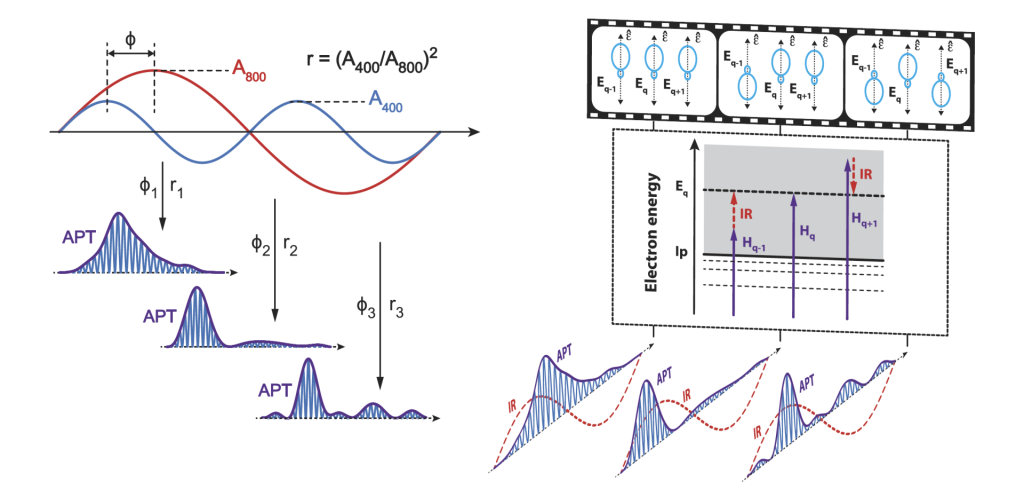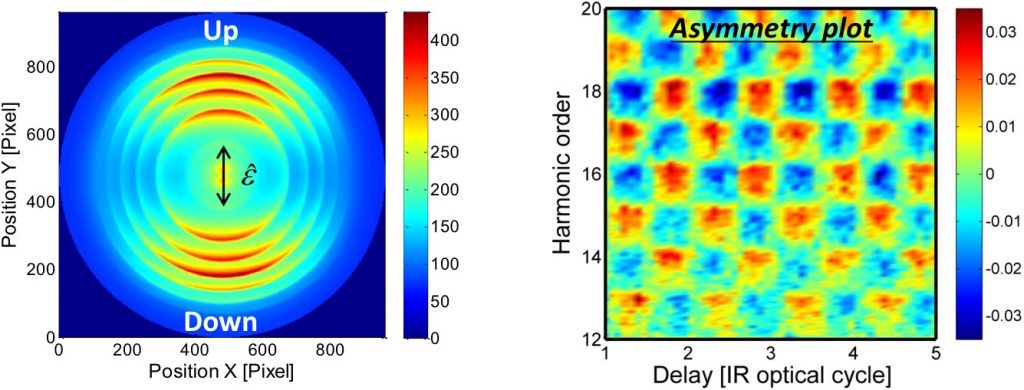1-Controlling electron dynamics at the attosecond timescale
Electron choreography at the attosecond time scale

In this work, we report on coherent control of electron dynamics in atoms via attosecond pulse-shaping. We show that the photoelectron emission from argon gas produced by absorption of an attosecond pulse train (APT) made of odd and even harmonics can be manipulated along the direction of polarization of the light by tuning the spectral components (amplitude and phase) of the pulse. In addition, we show that APTs produced with a two-color (400- plus 800 nm) femtosecond driving field exhibit high temporal tunability, which is optimized for an intensity ratio between the two colors in the range of 0.1 to 5%.
B. Unzicker et al., New Journal of Physics 23 013019 (2021)
Attosecond Control of Orbital Parity Mix Interferences

We experimentally demonstrate that atomic orbital parity mix interferences can be temporally controlled on an attosecond time scale. Electron wave packets are formed by ionizing argon gas with a comb of odd and even high-order harmonics, in the presence of a weak infrared field. Consequently, a mix of energy-degenerate even and odd parity states is fed in the continuum by one- and two-photon transitions. These interfere, leading to an asymmetric electron emission along the polarization vector. The direction of the emission can be controlled by varying the time delay between the comb and infrared field pulses. We show that such asymmetric emission provides information on the relative phase of consecutive odd and even order harmonics in the attosecond pulse train.
G. Laurent et al. Physical Review letters 109 083001 (2012)
G. Laurent et al. Journal of Physics: conference series 488 012008 (2014)
2 – Attosecond pulse characterization:
Improved Phase Retrieval by Omega Oscillation Filtering (iPROOF)

In this work we propose a novel procedure for the characterization of attosecond pulses. The method relies on the conversion of the attosecond pulse into electron wave-packets through photoionization of atoms in the presence of a weak IR field. It allows for the unique determination of the spectral phase making up the pulses by accurately taking into account the atomic physics of the photoionization process. The phases are evaluated by optimizing the fit of a perturbation theory calculation to the experimental result. The method has been called iPROOF (improved Phase Retrieval by Omega Oscillation Filtering). The procedure has been demonstrated for the characterization of an attosecond pulse train composed of odd and even harmonics. We observe a large phase shift between consecutive odd and even harmonics. The resulting attosecond pulse train has a complex structure not resembling a single attosecond pulse once per IR period, which is the case for zero phase. Finally, the retrieval procedure can be applied to the characterization of single attosecond pulses as well.
G. Laurent et al. Optics Express 21 16914 (2013)